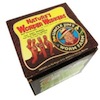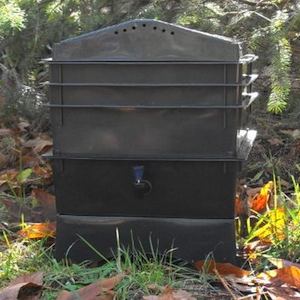Worm Composting Part One: An Introduction
Creating and maintaining a compost pile is a great way to get rid of organic waste, turning it into nutrient-rich compost perfect for feeding gardens or yards instead of sending it to a landfill.
But there instances where a conventional compost pile isn't necessary, convenient, or possible.
Luckily there are other options available for those who can't have a compost pile (or don't want one) but still want to keep organic waste out of the landfill.
Worm Composting (Vermicomposting)
One alternative to regular composting that is quickly gaining in popularity is worm composting, also known as vermicomposting.
This method of composting uses worms to eat organic waste matter and turn it into useful organic fertilizer.
Advantages of Worm Composting
There are several reasons why worm composting is becoming popular, and the advantages far outweigh the disadvantages. Some of worm compostings' advantages:
- Worm composting takes very little space.
- Worm composting is great for those living in apartments or condos who don't have yards or gardens, but still want to compost food scraps.
- Composting organic waste with worms reduces the amount of waste sent to landfills, or put into the wastewater stream.
- Worms turn organic waste into high quality fertilizer, perfect for gardens or indoor plants.
- Worm composting requires very little physical labor; the worms do all the work!
- Water and electricity usage is reduced, since worms eat the organic waste rather than it being put down a garbage disposal.
- Worm composting produces little odor and doesn't attract pests.
Worms: Nature's Garbage Disposal
The lowly worm is an amazing eating machine. Red wiggle worms, the type used in worm composters, can eat half their body weight in food every single day. A worm's digestive tract runs the entire length of their body. As they eat, food passes through the digestive system and is excreted as worm castings (poop), which resembles grains of black soil or coffee grounds. If any animal was 'Born To Eat', the worm is it.
The Worm Composting Bin
As your worms get to work eating (and pooping) the organic waste, the castings they produce blends with partially decomposed food scraps and worm bedding to form vermicompost, which is very similar to regular compost. Added to soil, vermicompost improves the soil's aeration, porosity, and water retention, all of which enhances plant growth.
In a worm bin, the worms do most of the work, but the microorganisms that work in outdoor compost systems are also present. The worms eat the microorganisms along with everything else, adding to the rich vermicompost.
Worm composting happens in temperatures ranging from 50 to 90 degrees. These temperatures are created by the worms and microorganisms as they work their magic. Worm composting doesn't work well in deep compost piles as the temperatures are too high, posing a threat to the worms. Worm composting works best with lots of horizontal surface area, about 8 to 12 inches deep. Most worm composters use shallow trays to hold the worms and their food. We'll discuss this in depth in our article on worm compost bins.
The Right Worm for the Job
There are many species of worms in the world, but only a few species will do a good job working as your waste composters. Buying worms from a bait shop or digging groundworms out of your yard might seem to make sense, but they won't have the chops to plow through your scraps. Worm composting calls for a worm that will thrive in the moist, shallow environment of a worm bin, and has an unstoppable appetite.
The most commonly used worm in worm composting is the red wiggler, also known as a branding, manure, or red worm. Another composting worm is the tiger worm, but since it's the leader by a long shot, we will refer to the red wiggler as 'the' composting worm.
Red wigglers live in moist, rich environments in nature such as decomposing matter under logs, or farm animal manure patties. They prefer to stay close to the surface where they have easy access to plenty of rotting organic matter. Yum! Since they love to live in shallow environments, not deep underground, and they can't seem to get enough of eating decomposing matter, red wigglers are perfect for life inside a household worm composting bin.
Where Do Compost Worms Come From?
No, they aren't delivered by a worm stork. Worms for composting bins are widely available through online garden supply stores, catalog mail-order, or through local garden or landscape stores. If you know somebody who is already composting with worms, they may be willing to give you some starter worms from their bin, since compost worms are not only prodigious eaters, but reproduce very quickly as well. A pound of worms (about 1,000 worms) is usually more than enough to get started.
In Part Two, we'll take a look at getting a worm compost bin up and running....
Interested In More On Composting?
We offer a lot of information on composting and some great composting product reviews. If you really want to get your feet wet in the composting business, be sure to read these additional articles of interest:
Composting 101
Worm Composting
Vermiculture - A Worms Healthy Home
Vermicomposting - Troubleshooting Tips
Compost Pit
Compost Container
Making Compost
Soil Saver Classic Composter Product Review
GeoBin Composting Container Product Review
Worm Factory 360 Product Review






































































